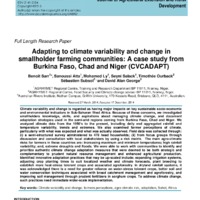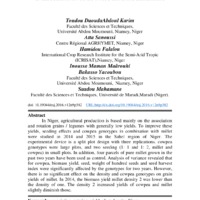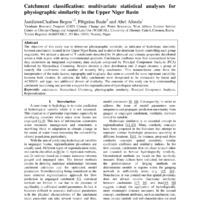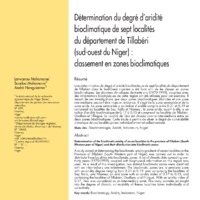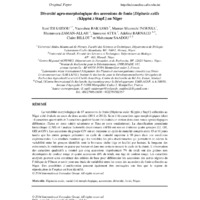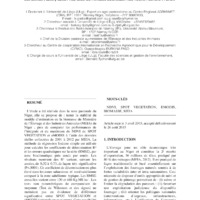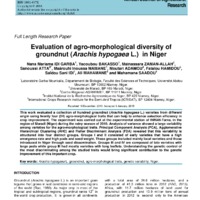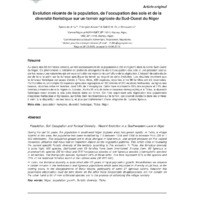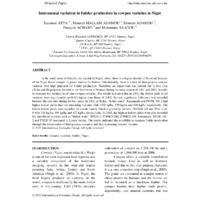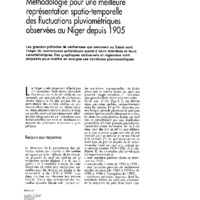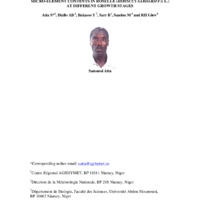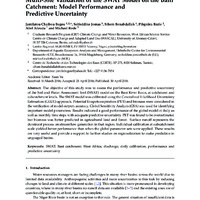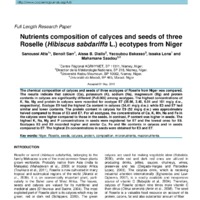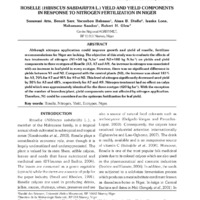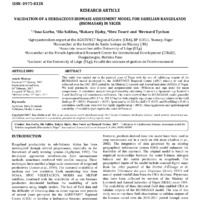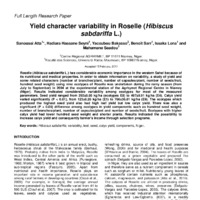Recherche
20 items
Adapting to climate variability and change in smallholder farming communities: a case study from Burkina faso, Chad and Niger
Climate variability and change is regarded as having major impacts on key sustainable socio-economic and environmental indicators in Sub-Saharan West Africa. Because of these concerns, we investigated smallholders knowledge, skills, and aspirations about managing climate change, and document adaptation strategies used in the semi-arid regions coming from Burkina Faso, Chad and Niger. We analyzed climate data from the 1950’s to the present, including daily and aggregated rainfall and temperature variability, trends and extremes.
Amelioration Du Rendement Du Mil Par L’association Avec Le Niebe En Zone Sahelienne
Au Niger, la production agricole est essentiellement basée sur l’association et la rotation céréales/légumineuses avec des rendements généralement faibles. Afin d’améliorer ces rendements, les effets de densités de semis et de génotypes de niébé en association avec le mil ont été étudiés en 2014 et 2015 en zone sahélienne du Niger. Le dispositif expérimental est un split plot à trois répétitions. Les génotypes de niébé étaient en grandes parcelles, et les deux densités de semis (1 :1 et 1 :2, mil et niébé) en petites parcelles. Par ailleurs, quatre parcelles de mil pur cultivées au cours des deux années ont été utilisées comme témoin. L’analyse de variance révèle que pour le niébé, le rendement en biomasse, en graines, le poids de cent graines et l’indice de récolte en graines ont été significativement affectés par les génotypes pendant les deux années. Cependant, il n’y’avait aucun effet significatif de la densité et de génotypes de niébé sur les rendements en grains du mil. En 2014, le rendement en biomasse de mil à la densité 2 était inférieur à celui de la densité 1. La densité 2 augmentait les rendements du niébé et diminuent faiblement ceux du mil.
Catchment classification: multivariate statistical analyses for physiographic similarity in the upper niger basin
The objective of this study was to determine physiographic similarity, as indicator of hydrologic similarity between catchments located in the Upper Niger Basin, and to derive the dominant factors controlling each group singularity. We utilized a dataset of 9 catchments described by 16 physical and climatic properties distributed across a wide region with strong environmental gradients. Catchments attributes were first standardized before they underwent an integrated exploratory data analysis composed by Principal Component Analysis (PCA) followed by Hierarchical Clustering. Results showed a clear distribution into 2 major clusters: a group of easterly flat catchments and another of westerly hilly catchments. This nomenclature came from the interpretation of the main factors, topography and longitude, that seem to control the most important variability between both clusters. In addition, the hilly catchments were designated to be dominated by forest and ACRISOL soil type, two additional drivers of similarity. The outcome of this study can help understanding catchment functioning and provide a support for regionalization of hydrological information.
Détermination du degré d’aridité bioclimatique de sept localités du département de tillabéri (sud-ouest du niger): classement en zones bioclimatiques
Une détermination du degré d’aridité bioclimatique de sept localités du département de Tillabéri dans le Sud-Ouest nigérien a été faite afin de les classer en zones bioclimatiques. Les données climatiques de trente ans (1970-1999), couplées avec des informations biophysiques de cette région ont été utilisées pour cet exercice. Il ressort de ces investigations que deux zones bioclimatiques distinctes et une zone intermédiaire peuvent être mises en évidence. Il s’agit de la zone semi-aride et de la zone aride. La zone semi-aride a un indice d’aridité compris entre 0,21 et 0,19 et comprend les localités de Say, Kollo et Niamey ; la zone aride, quant à elle, a un indice d’aridité bioclimatique de 0,17 à 0,15 et comprend les localités de Tillabéri, Ouallam et Fillingué. La localité de Téra est classée comme intermédiaire entre les deux zones bioclimatiques.
Diversité agro-morphologique des accessions de fonio [Digitaria exilis (Kippist.) Stapf.] au Niger
La variablité morphologique de 67 accessions de fonio [Digitaria exilis (Kippist.) Stapf.] collectées au Niger a été évaluée au cours de deux années (2011 et 2012). Seize (16) caractères agro morphologiques (dont 14 caractères quantitatifs et 2 caractères qualitatifs) ont été évalués en station dans deux zones agroécologiques différentes (Tarna en zone sahélo-saharienne et Tara en zone soudanienne). La classification acsendante hierarchique (CAH) et l’analyse factorielle discriminante (AFD) ont mis en évidence quatre groupes (GI, GII, GIII et GIV). Les accessions du groupe GIV ont en moyenne un cycle de maturité compris entre 85 et 90 jours tandis que les autres groupes présentent un cycle de maturité superieur à 90 jours dans nos conditions expérimentales. Les résultats montrent que les variables les plus discriminantes qui permettent de décrire la variabilité entre les groupes identifiés sont la biomasse sèche (tige et feuille) par hectare, la longueur des entrenoeuds, le rendement en graine par hectare et dans une certaine mesure le cycle de la plante. L’observation des caractères qualitatifs a montré que cinq accessions (représentant 7& du total) ont des graines non decortiquées de couleur rouge et quatre accessions (6& du total), une tige de couleur rouge. Les caractères analysés peuvent ainsi constituer des critères de base pour différencier les accessions des autres régions de l’Afrique de l’Ouest et servir pour une étude de variabilité entre les restes des accessions de fonio collectées au Niger. Des possiblités d’amélioration peuvent également être envisagées une fois que le regime de réproduction de l’espèce est bien identifié.
Etude de la variabilité génétique de 19 accessions de voandzou « Vigna subterranea (L.) Verdcourt » de l’Extrême et du centre Est du Niger
Le voandzou (Vigna subterranea [L.] Verdc.), culture du nouveau millénaire, est considéré comme une des principales légumineuses des régions tropicales en raison de ses avantages polyvalents. Cette étude a pour objectif principale d’estimer la variation des accessions locales de l’arachide bambara en tenant compte de leurs 21 caractères quantitatifs, afin de découvrir le meilleur génotype adapté au Niger. L’étude est réalisée selon un dispositif en blocs de Fisher complètement randomisé avec quatre répétitions. Vingt-un (21) caractères dont quatre (4) phénologiques, cinq (5) morphologiques et douze (12) liés au rendement ont été évalués pour caractériser les accessions. Avec les 21 caractères des accessions utilisées, la variation des paramètres génétiques a été déterminée. L’analyse de la variance a révélée des variations significatives pour tous les caractères évalués (P≤0,01). Les coefficients de variation varient de 0,57% à 32,11%. Six (6) des vingt-un (21) paramètres mesurés ont des coefficients de variations élevés (CV˃20%). Le rendement a présenté une corrélation fortement positive avec des paramètres tels que le nombre de feuilles (r=0,62), le nombre de gousses (r=0,68), le nombre de pétioles par plante (r=0,62), le poids de 100 graines (r=0,79), le poids de gousses (r=0,97) et le poids de graines (r=0,97). Le poids de graines (GCV=23,40% et PCV=42,54%), le poids de 100 graines (GCV=25,73% et PCV=25,75%) et le rendement en Kg/ha (GCV=23,40% et PCV=42,54%) ont révélé des coefficients de variation phénotypique et génotypique élevés (˃20%). La date de maturité (91,28%) et le poids de 100 graines (96,85%)
Evaluation des ressources pastorales au Sahel Nigérien à l'aide des données NDVI issues de SPOT végétation
L’étude a été réalisée dans la zone pastorale du Niger, elle se propose de : tester la stabilité du modèle d’estimation de la biomasse du Ministère de l’Élevage et des Industries Animales (MEIA) du Niger ; puis de comparer les performances de l’intégrale et du maximum du NDVI de SPOT VEGETATION et eMODIS à l’aide des données réelles collectées de 2001 à 2012 par MEIA. La méthode de régression linéaire simple est utilisée pour calculer les coefficients de détermination R² et les erreurs quadratiques sur la série (RMSE), par zone bioclimatique puis année par année. Les résultats montrent des R² variant, suivant les années, de 0,52 à 0,73, de façon très significative (P<.0001). Ce coefficient de détermination est plus élevé dans les zones saharienne et nord sahélienne comparé à la zone sahélienne typique. Les RMSE annuelles varient entre 120 et 460 Kg.MS.ha-1. Les tests non paramétriques de comparaison de moyenne (Test de Wilcoxon et des signes) ne mettaient pas en évidence de différence significative entre SPOT VEGETATION et eMODIS (intégrale ou maximum). Cette possibilité d’intercomparabilité des indices provenant de différents capteurs permet aux utilisateurs d’assurer la production sans interruption avec une possibilité d’analyse convergente si l’un des deux capteurs était indisponible
Evaluation des ressources pastorales au sahel nigérien à l'aide des données NDVI issues de spot-vegetation et modis
L’étude a été réalisée dans la zone pastorale du Niger, elle se propose de : tester la stabilité du modèle d’estimation de la biomasse du Ministère de l’Élevage et des Industries Animales (MEIA) du Niger ; puis de comparer les performances de l’intégrale et du maximum du NDVI de SPOT VEGETATION et eMODIS à l’aide des données réelles collectées de 2001 à 2012 par MEIA. La méthode de régression linéaire simple est utilisée pour calculer les coefficients de détermination R² et les erreurs quadratiques sur la série (RMSE), par zone bioclimatique puis année par année. Les résultats montrent des R² variant, suivant les années, de 0,52 à 0,73, de façon très significative (P<.0001). Ce coefficient de détermination est plus élevé dans les zones saharienne et nord sahélienne comparé à la zone sahélienne typique. Les RMSE annuelles varient entre 120 et 460 Kg.MS.ha-1. Les tests non paramétriques de comparaison de moyenne (Test de Wilcoxon et des signes) ne mettaient pas en évidence de différence significative entre SPOT VEGETATION et eMODIS (intégrale ou maximum). Cette possibilité d’intercomparabilité des indices provenant de différents capteurs permet aux utilisateurs d’assurer la production sans interruption avec une possibilité d’analyse convergente si l’un des deux capteurs était indisponible.
Evaluation of agro-morphological diversity of groundnut (Arachis hypogaea L.) in Niger
This work evaluated a collection of hundred groundnut (Arachis hypogaea L.) varieties from different origin using twenty four (24) agro-morphological traits that can help to enhance selection efficiency in crop improvement. The experiment was carried out at the experimental station of INRAN-Tarna, in the region of Maradi (Niger) during the rainy season of 2010. Analysis of variance showed a large variability among varieties for the agro-morphological traits. Principal Component Analysis (PCA), Agglomerative Hierarchical Clustering (AHC) and Fisher Discriminant Analysis (FDA) revealed that this variability is structured into four distinct groups. Groups I and II consisted of early varieties that have a high emergence rate and high pods and seed weight. These groups included mainly local varieties and those introduced in Niger through seed dissemination. Groups III and IV are composed of late varieties with large pods while group III had mostly varieties with long leaflets. Understanding the genetic control of the most discriminating among the studied traits would bring significant contribution to the genetic improvement of this important crop.
Evaluation of the Impact of Seasonal Agroclimatic Information Used for EarlyWarning and Farmer Communities’ Vulnerability Reduction in Southwestern Niger
Abstract: In Niger (a fully Sahelian country), the use of climate information is one of the early warning strategies (EWSs) for reducing socio-economic vulnerabilities in farmer communities. It helps farmers to better anticipate risks and choose timely alternative options that can allow them to generate more profit. This study assesses the impacts of the use of climate information and services that benefit end-users. Individual surveys and focus groups were conducted with a sample of 368 people in eight communes in Southwestern Niger. The survey was conducted within the framework of the
ANADIA project implemented by the National Meteorological Direction (NMD) of Niger. The survey aims to identify different types of climate services received by communities and evaluates the major benefits gained from their use. Mostly, the communities received climate (73.6%) and weather (99%) information on rainfall, temperature, dust, wind, clouds, and air humidity. Few producers in the area (10%) received information on seasonal forecasts of the agrometeorological characteristics of the rainy season. The information is not widely disseminated in the villages during the roving seminars conducted by the NMD. For most people, this information is highly relevant to their needs because of its practical advice for options to be deployed to mitigate disasters for agriculture, livestock, health, water resources, and food security. In those communities, 82% of farmers have (at least once) changed their routine practices as a result of the advice and awareness received according to the climate
information. The information received enables farmers (64.4%) to adjust their investments according to the profile of the upcoming rainfall season. The use of climate information and related advice led to an increase of about 64 bunches (equivalent to 10 bags of 100 kg) in annual millet production, representing an income increase of about 73,000 FCFA from an average farmland of 3 ha per farmer. In addition, the use of climate information helps to reduce the risks of floods and droughts, which often cause massive losses to crop production, animal and human life, infrastructure, materials, and goods. It has also enabled communities to effectively manage seeds and animal foods and to plan
social events, departures and returns to rural exodus. These analyses confirm that the use of climate information serves as an EWS that contributes to increasing the resilience of local populations in the Sahel.
Evolution récente de la population, de l’occupation des sols et de la diversité floristique sur un terroir agricole du Sud-Ouest du Niger
Au cours des 50 dernières années, un fort accroissement de la population a été enregistré dans la partie Sud-Ouest du Niger. Ce phénomène a entraîné de profonds changements dans l’occupation des sols et une pression accrue sur les ressources naturelles qui ont eu une incidence importante sur l’allure de la végétation. L’objectif de cette étude est de faire le point sur la richesse spécifique du terroir au regard de cette évolution. Les résultats montrent que la richesse floristique est assez élevée à Ticko. Ainsi, 400 espèces, réparties entre 66 familles ont été recensées. Parmi celles-ci, on compte 85 espèces ligneuses regroupées en 32 familles et 315 espèces herbacées, ou ligneuses basses, réparties entre 44 familles, dont 64& de Thérophytes. Cette flore représente 65& des espèces et 71& des familles présentes dans la région du Liptako. Après 25 ans de forte croissance démographique à Ticko, la diversité floristique reste encore à peu près intacte dans ce terroir. On note cependant une régression des populations d’espèces herbacées et ligneuses, autrefois bien représentées sur le terroir, qui pourrait conduire dans les années à venir à la disparition de ces taxons, et plus particulièrement d’une vingtaine de taxons ligneux.
Interannual variation in fodder production in cowpea varieties in Niger
In the south areas of Niamey, the capital of Niger, where there is a higher density of livestock because of the Niger River, cowpea is grown mainly for fodder. Unfortunately, there is a lack of dual-purpose cowpea varieties with high potential for fodder production. Therefore, an experiment was carried out in two sites (Ticko and Bogodjotou) located in the Southwest of Niamey during the rainy season of 2001 and 2002, in order to compare the production of nine cowpea varieties. The results indicated that in 2001, the fodder yield of all varieties were significantly (p<0.01) higher than those of 2002. But not significant difference was recorded between the two sites during the two years. In 2001, at Ticko, “Baban waké", Kanannado and IT93K-398-2 had higher fodder yields than the remaining varieties with 1032 kg/ha, 879 kg/ha and 866 kg/ha respectively. The lowest fodder yields were recorded for Locale variety which is grown by farmers, IT89KD-349 and TVu 1234- 9 with 715 kg/ha, 499 kg/ha and 677 kg/ha, respectively. In 2002, the highest fodder yields were also recorded for introduced varieties such as “Baban waké", IN92E-3, IT89KD-288, IT89KD-349, Kanannado, IT93K-398- 2 and TN256-87 compared to Locale variety. The results indicated the possibility to increase fodder production through the introduction of dual-purpose cowpeas and thus increasing farmers’ income. © 2011 International Formulae Group. All rights reserved.
MICRO-ELEMENT CONTENTS IN ROSELLE (HIBISCUS SABDARIFFA L.) AT DIFFERENT GROWTH STAGES
In the western Sahel, leaves of Roselle (Hibiscus sabdariffa) have considerable economic importance because of their nutritional and medical uses. These plant organs are used to supplement nutrients provided by cereals such as millet and sorghum. However, there is a lack of information on the nutrient composition of these plant organs of Roselle at different growth stages. Therefore, the experiment was carried out under rainfall conditions during the 2006 rainy season (from July to September) at the experimental station of the Agrhymet Regional Centre in Niamey (Niger). The content of the micronutrients Fe, Mn, Cu and Zn in leaves of three ecotypes of Roselle (A3, A7 and A9) at three growth stages, vegetative (stage I), flowering (stage II), and mature (stage III) was determined. The experimental design was a randomized complete block with four replicates and one variable (ecotype). Results indicated that at stage I, ecotype A3 had higher Fe content in leaves. In addition, A3 had also the highest Zn content in leaves at stage I. For all three ecotypes, Fe and Zn content in the leaves decreased significantly (p<0.05) from stage I to stage II, then remained constant until stage III. For Fe, the decrease between stage I and II was 37& for A3 and 50&, respectively for A7 and A9. The corresponding decrease of Zn content was 30& for A7 and 50&, respectively, for A3 and A9. The Mn content in the leaves of Roselle was similar for the three ecotypes at stage I, thereafter increased continuously during plant growth. From stage I to II, the increase was about 90&, 70& and 50&, respectively for A9, A7 and A3. From stage II to III, the increase in Mn content in the leaves was significantly (p<0.05) higher for A3 and A7, respectively 180& and 80&. At stages I and II, the highest Cu content was recorded for A3 and the lowest one for A7. During the whole cycle of plant growth, the Cu content in the leaves was relatively constant for A9. In contrast, Cu content in the leaves decreased for the remaining ecotypes. Therefore the vegetative stage corresponding to 25 days after sowing is the recommended optimal harvest time of Roselle to maximise on the nutrients.
Multi-site validation of the swat model on the bani catchment: model performance and predictive uncertainty
The objective of this study was to assess the performance and predictive uncertainty of the Soil and Water Assessment Tool (SWAT) model on the Bani River Basin, at catchment and subcatchment levels. The SWAT model was calibrated using the Generalized Likelihood Uncertainty Estimation (GLUE) approach. Potential Evapotranspiration (PET) and biomass were considered in theverificationofmodeloutputsaccuracy. GlobalSensitivityAnalysis(GSA)wasusedforidentifying important model parameters. Results indicated a good performance of the global model at daily as well as monthly time steps with adequate predictive uncertainty. PET was found to be overestimated but biomass was better predicted in agricultural land and forest. Surface runoff represents the dominant process on streamflow generation in that region. Individual calibration at subcatchment scale yielded better performance than when the global parameter sets were applied. These results are very useful and provide a support to further studies on regionalization to make prediction in ungauged basins.
Nutrients composition of calyces and seeds of three Roselle (Hibiscus sabdariffa L.) ecotypes from Niger
The chemical composition of calyces and seeds of three ecotypes of Roselle from Niger was compared. The results indicate that calcium (Ca), potassium (K), sodium (Na), magnesium (Mg) and protein contents in calyces are significantly different (P<0.005) among ecotypes. The highest concentrations of K, Na, Mg and protein in calyces were recorded for ecotype E7 (35.66, 3.40, 6.01 and 101 mg/g d.w., respectively). Ecotype E9 had the highest Ca content in calyces (34.41 mg/g d.w.); while E3 and E7 had similar and lower contents. The protein content in calyces for E9 (52 mg/g d.w.) was approximately halved compared to those of E3 and E7. For all ecotypes, the concentrations of Ca, K, Mn, Na and Fe in the calyces were higher compared to those in the seeds. In contrast, P content was higher in seeds. The highest K, Na, Mg and P concentrations in seeds were registered for E7 and the lowest ones for E9. Ecotypes E3 and E9 recorded higher and similar Cu, Fe and Mn contents in calyces and in seeds compared to E7. The highest Zn concentrations in seeds were obtained for E3 and E7.
ROSELLE (HIBISCUS SABDARIFFA L.) YIELD AND YIELD COMPONENTS IN RESPONSE TO NITROGEN FERTILIZATION IN NIGER
Although nitrogen application could improve growth and yield of roselle, fertilizer recommendations for Niger are lacking. The objective of this study was to evaluate the effects of two treatments of nitrogen (N1=50 kg N,ha-1 and N2=100 kg N.ha-1) on yields and yield components in three ecotypes of Roselle (A3, A7 and A9). An increase in nitrogen was associated with an increase in leaf yield in every ecotype. However, there was no significant difference in yields between N1 and N2. Compared with the control plants (N0), the increase was about 181& for A3, 70& for A7 and 95& for A9 at N2. This level of nitrogen significantly decreased seed yield by 30& for A3 and 48&, respectively for A7 and A9. Nitrogen treatment had no effect on calyx yield which was approximately identical for the three ecotype (420 kg ha-1). With the exception of the number of branches/plant, yield components were not affected by nitrogen application. Therefore, N1 could be considered as the optimum fertilization for leaf yield.
Validation of a herbaceous biomass assessment model for selected rangelands
This study was carried out in the pastoral zone of Niger with the aim to validating outputs of the BIOMASAH model developed by the AGRHYMET Regional Centre (ARC) relative to real data collected over the 2001 2011 period by the Ministry of Livestock and Animal Industries of Niger
VARIATION IN MACRO-ELEMENTS AND PROTEIN CONTENTS OF ROSELLE (HIBISCUS SABDARIFFA L.) FROM NIGER
Roselle is an important part of the human diet in many countries, particularly in the Sahel zone of West Africa. The leaves of Roselle are consumed as a green vegetable and in sauce. Nevertheless, little attention has been paid to their nutrient composition at different stages of plant growth. Therefore, an experiment was carried out under rainfall conditions from July to September 2006 at the experimental station of the Agrhymet Regional Centre in Niamey (Niger). The contents of Ca, K, Mg, P and protein in leaves of three ecotypes (A3, A7 and A9) were determined at stages I, II and III, corresponding, respectively to vegetative, flowering and mature stages. The experimental design was a randomized complete block with four replicates and one variable (ecotype). For ecotype A7, the protein content of the leaves decreased significantly (p<0.05) between stage I and II, than remained relatively constant up to stage III. In contrast for A3 and A9, protein content in leaves decreased significantly (p<0.05) between stage II and III. From stage I to III, the decrease of protein content in leaves was 41& for ecotype A3, 50& for A7 and 66& for A9. For all ecotypes, the P content of the leaves decreased progressively during plant growth. For A7 and A9, the reduction in P content from stage I to II and from II to III was about the same, namely 30&. However, for ecotype A3, the decrease was greater, respectively, 37& and 46&. The Mg content of the leaves was relatively constant for all three ecotypes at a given stage of plant development. However, the Mg content of the leaves decreased significantly (p<0.05) from flowering to maturity: 28& for A3, 23& for A9 and 14& for A7. For the three ecotypes, the Ca content of the leaves remained relatively constant from stage I to II, than increased markedly from stage II to III, to about 150& for A7, 85& for A3 and 50& for A9. From stage I to II, the leaves’ K content decreased significantly for all three ecotypes, about 67& for A9, 62& for A3 and 44& for A7. The data indicated that Roselle can contribute useful amounts of essential nutrients such as Ca K, Mg, N and P mainly at vegetative stage in the diets of people who inhabit the western Sahel.
Yield character variability in Roselle (Hibiscus sabdariffa L.)
Roselle (Hibiscus sabdariffa L.) has considerable economic importance in the western Sahel because of its nutritional and medical properties. In order to obtain information on variability, a study of yield and some related characters (number of branches/plant, number of capsules/plant, number of seeds/fruit, hundred seed weight) using nine ecotypes of Roselle was undertaken during the rainy season (from July to September) in 2004 at the experimental station of the Agrhymet Regional Centre in Niamey (Niger). Results indicated considerable variability among ecotypes for most of the measured parameters. Seed yield ranged from 292±8.80 kg/ha (ecotypes E8) to 497±8.91 kg/ha (E4). Calyx yield varied significantly (P < 0.01), from 123±8.26 kg/ha (E1) to 766±36.81 kg/ha (E9). The ecotypes which produced the highest seed yield also had high leaf yield but low calyx yield. There was also a significant (P < 0.05) difference among ecotypes in yield components such as hundred seed weight, number of branches/plant, number of capsules/plant and number of seeds/fruit. Ecotypes with higher calyx yield had lower hundred seed weight and shorter plants. Results indicated the possibility to increase calyx yield and consequently farmer’s income through selection programs.
